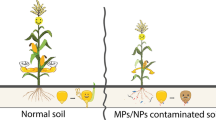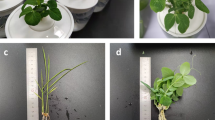Summary
In clonal plants exposed to pollution, ramets which are physiologically integrated may be less fit than ramets which are independent, if (a) translocation of toxins from contaminated ramets produced toxicity, or (b) toxicity in parent ramets reduced the degree of nutritional support to otherwise non-exposed daughters. These hypotheses were tested in the aquatic fern Salvinia molesta exposed to cadmium. Pre-treatment of parent ramets with cadmium decreased the number and biomass of daughters subsequently produced in a cadmiumfree medium, because of reduced parental support of the first daughter generation. Second generation and later daughters were unaffected. Pre-treatment did not affect the pattern of integration (which, in terms of apical daughters' biomass, was bimodal with increasing colony size), or concentrations of essential elements in new growth. However, a diversion of resources from lateral to apical daughters occurred as a result of pre-treatment, especially in colonies with ≤3 attached parents. Loss/gain analysis showed that the diversion was almost reciprocal in terms of biomass, ramet numbers and phosphorus content. Integration between contaminated and uncontaminated ramets was not disadvantageous to the clone as a whole. However, integration was disadvantageous for Ca, Mg and Zn concentrations in daughters, which declined 15–22%. Because of enhanced apical growth, an indirect benefit of integration may be a more rapid fragmentation and dispersal of daughters from the site of contamination than if the parents were independent.
Similar content being viewed by others
References
Bernard JM, Solsky BA (1977) Nutrient cycling in a Carex lacustris wetland. Can J Bot 55: 630–638
Bidwell RGS (1979) Plant Physiology, Second Ed. Macmillan Publishing, New York
Cook RE (1985) Growth and development in clonal plant populations. In: Jackson BC, Buss JW, Cook RE (eds) Population biology and evolution of clonal organisms. Yale University Press, pp 259–296
Cunningham LM, Collins FW, Hutchinson TC (1975) Physiological and biochemical aspects of cadmium toxicity in soybean. I. Toxicity symptoms and autoradiographic distribution of Cd in roots, stems and leaves. Proc 1st Int Conf Heavy Metals in the Environment, Toronto Oct 1975, Vol II Part 1, pp 97–120
Dabin P, Marafante E, Mousny JM, Myttenaere C (1978) Absorption, distribution and binding of cadmium and zinc in irrigated rice plants. Plant Soil 50: 329–341
Forno IW, Semple JL (1987) Response of Salvinia molesta to insect damage: changes in nitrogen, phosphorus and potassium content. Oecologia 73: 71–74
Ginzo HD, Lovell PH (1973) Aspects of the comparative physiology of Ranunculus bulbosus L. and Ranunuclus repens L. II. Carbon dioxide assimilation and distribution of photosynthates. Ann Bot 37: 765–776
Harnett DC, Bazzaz FA (1983) Physiological integration among intraclonal ramets of Solidago canadensis in an abandoned field. Ecology 64: 779–788
Harnett DC, Bazzaz FA (1985) The integration of neighbourhood effects by clonal genets of Solidago canadensis. J Ecol 73: 415–428
Hoagland DR, Arnon DI (1950) The water culture method for growing plants without soil. California Agricultural Experimental Station Circ. No. 347
Jarvis SC, Jones LHP, Hopper NJ (1976) Cadmium uptake from solution by plants and its transport from roots to shoots. Plant Soil 44: 179–191
Jonsdottir IS, Callaghan TV (1989) Localized defoliation stress and the movement of 14C-photoassimilates between tillers of Carex begelowii. Oikos 54: 211–219
Julien MH, Bourne AS (1986) Compensatory branching and changes in nitrogen content in the aquatic weed Salvinia molesta in response to disbudding. Oecologia 70: 250–257
Newell SJ (1982) Translocation of 14C-photoassimilate in two stoloniferous Viola species. Bull Torry Bot Club 109 306–317
Noble JC, Marshall C (1983) The population biology of plants with clonal growth. II. The nutrient strategy and modular physiology of Carex arenaria. J Ecol 71: 865–877
Ong CK, Marshall C (1979) The growth and survival of severelyshaded tillers in Lolium perenne L. Ann Bot 43: 147–155
Pitelka LF, Ashmun JW (1985) Physiology and integration of ramets in clonal plants. In: Jackson BC, Buss JW, Cook RE (eds) Population biology and evolution of clonal organisms. Yale University Press, pp 399–435
Qureshi FA, Spanner DC (1971) Unidirectional movement of tracers along the stolon of Saxifraga sarmentosa. Planta 101: 133–146
Room PM (1983) ‘Falling apart’ as a lifestyle: the rhizome architecture and population growth of Salvinia molesta. J Ecol 71: 349–365
Room PM (1988) Effects of temperature, nutrients and a beetle on branch architecture of the floating weed Salvinia molesta and simulations of biological control. J Ecol 76: 826–848
Salzman AG, Parker MA (1985) Neighbours ameliorate local salinity stress for a rhizomatous plant in a heterogeneous environment. Oecologia 65: 273–277
SAS (1985) SAS/STAT guide for personal computers. Version 6 Ed. SAS Institute Inc
Sela M, Tel-Or E, Fritz E, Huttermann A (1988) Localization and toxic effects of cadmium, copper, and uranium in Azolla. Plant Physiol 88: 30–36
Slade AJ, Hutchings MJ (1987) An analysis of the costs and benefits of physiological integration between ramets in the clonal perennial herb Glechoma hederacea. Oecologia 73: 425–431
Tietema T, Van Der Aa F (1981) Ecophysiology of the sand sedge, Carex arenaria L. III. Xylem translocation and the occurrence of patches of vigorous growth within the continuum of a rhizomatous plant system. Acta Bot Neerl 30: 183–189
Watson MA, Casper BB (1984) Morphogenetic constraints on patterns of carbon distribution in plants. Ann Rev Ecol Syst 15: 233–258
Williams RF (1955) Redistribution of mineral elements during development. Ann Rev Plant Physiol 6: 25–42
Author information
Authors and Affiliations
Rights and permissions
About this article
Cite this article
Outridge, P.M., Hutchinson, T.C. Effects of cadmium on integration and resource allocation in the clonal fern Salvinia molesta . Oecologia 84, 215–223 (1990). https://doi.org/10.1007/BF00318274
Received:
Accepted:
Issue Date:
DOI: https://doi.org/10.1007/BF00318274




